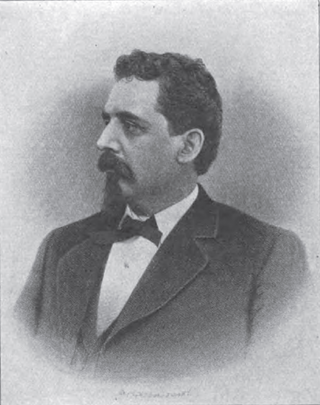
Toledo is a city in and the county seat of Lucas County, Ohio, United States. At the 2020 census, it had a population of 270,871, making Toledo the fourth-most populous city in the state of Ohio, after Columbus, Cleveland, and Cincinnati. Toledo is also the 79th-largest city in the United States. It is principal city of the Toledo metropolitan area, which had 646,604 residents in 2020. Toledo also serves as a major trade center for the Midwest; its port is the fifth-busiest on the Great Lakes.
The Toledo War (1835–36), also known as the Michigan–Ohio War or the Ohio–Michigan War, was a boundary dispute between the U.S. state of Ohio and the adjoining territory of Michigan over what is now known as the Toledo Strip. Control of the mouth of the Maumee River and the inland shipping opportunities it represented, and the good farmland to the west were seen by both parties as valuable economic assets.
The following is timeline of events surrounding the Toledo War, a mostly bloodless conflict between the State of Ohio and the Michigan Territory in 1835–36, over a 468-square-mile (1,210 km2) disputed region along their common border, now known as the Toledo Strip after its major city.

The Great Black Swamp was a glacially fed wetland in northwest Ohio, sections of lower Michigan, and extreme northeast Indiana, United States, that existed from the end of the Wisconsin glaciation until the late 19th century. Comprising extensive swamps and marshes, with some higher, drier ground interspersed, it occupied what was formerly the southwestern part of proglacial Lake Maumee, a Holocene precursor to Lake Erie. The area was about 25 miles (40 km) wide and 100 miles (160 km) long, covering an estimated 1,500 square miles (4,000 km2). Gradually drained and settled in the second half of the 19th century, it is now highly productive farmland. However, this development has been detrimental to the ecosystem as a result of agricultural runoff. This runoff, in turn, has contributed to frequent toxic algal blooms in Lake Erie.

The Brass Era is an American term for the early period of automotive manufacturing, named for the prominent brass fittings used during this time for such features as lights and radiators. It is generally considered to encompass 1896 through 1915, a time when cars were often referred to as horseless carriages.
The Lake Shore and Michigan Southern Railway, established in 1833 and sometimes referred to as the Lake Shore, was a major part of the New York Central Railroad's Water Level Route from Buffalo, New York, to Chicago, Illinois, primarily along the south shore of Lake Erie and across northern Indiana. The line's trackage remains a major rail transportation corridor used by Amtrak passenger trains and several freight lines; in 1998, its ownership was split at Cleveland between CSX Transportation to the east and Norfolk Southern Railway in the west.

Vistula Historic District is a designated historic district in the city of Toledo, Ohio, USA, listed on the National Register of Historic Places. The district comprises Toledo's oldest neighborhood and encompasses an area roughly bounded by Champlain, Summit, Walnut and Magnolia streets.

Toledo Express Airport, officially Eugene F. Kranz Toledo Express Airport, is a civil-military airport in Swanton and Monclova townships 10 mi (16 km) west of Toledo in western Lucas County, Ohio, United States. It opened in 1954-55 as a replacement to then Toledo Municipal Airport southeast of Toledo. TOL is near the crossing of State Route 2 and the Ohio Turnpike.

Samuel Milton "Golden Rule" Jones (1846–1904) was a Progressive-Era Mayor of Toledo, Ohio from 1897 until his death in 1904. Jones was famous for his outspoken advocacy of the proverbial ethic of reciprocity or "Golden Rule," hence his nickname.

The Diocese of Toledo in America is a Latin Church ecclesiastical jurisdiction, or diocese, of the Catholic Church covering nineteen counties in northwestern Ohio in the United States.

Martin Luther King Jr. Plaza is the main passenger rail and intercity bus station of Toledo, Ohio.
The Toledo–Lucas County Port Authority is a port authority financing and/or operating air, rail, trucking, and port facilities, as well as supporting and funding economic development activities in Lucas County, located in northwest Ohio and bordering on southeast Michigan.

James Harding Southard was an American lawyer and politician who served six terms as a U.S. Representative from Ohio from 1895 to 1907.

Harvard Terrace is a historic neighborhood in Toledo, Ohio; it is "bordered by Amherst Drive, Broadway, Glendale Avenue, and the Anthony Wayne Trail. It includes 435 residences, many of them designed by architects and built in the early 1900s."

Toledo Executive Airport is seven miles southeast of Toledo, in Wood County, Ohio. It is an FAA designated reliever to Toledo Express Airport (TOL), Toledo's primary airport. Toledo Executive Airport was renamed from Metcalf Field in 2010.

Toledo Lucas County Public Library is a public library system located in Toledo, Ohio.

Ulysses Grant Denman was a Republican politician from the state of Ohio. He was Ohio Attorney General from 1908-1911.

John Hardy Doyle was a Republican politician in the U.S. State of Ohio who was an Ohio Supreme Court Judge during 1883.

Lasalle & Koch Co. or Lasalle's was a department store in Toledo, Ohio, with branches in some nearby communities.
The following is a timeline of the history of the city of Toledo, Ohio, USA.















